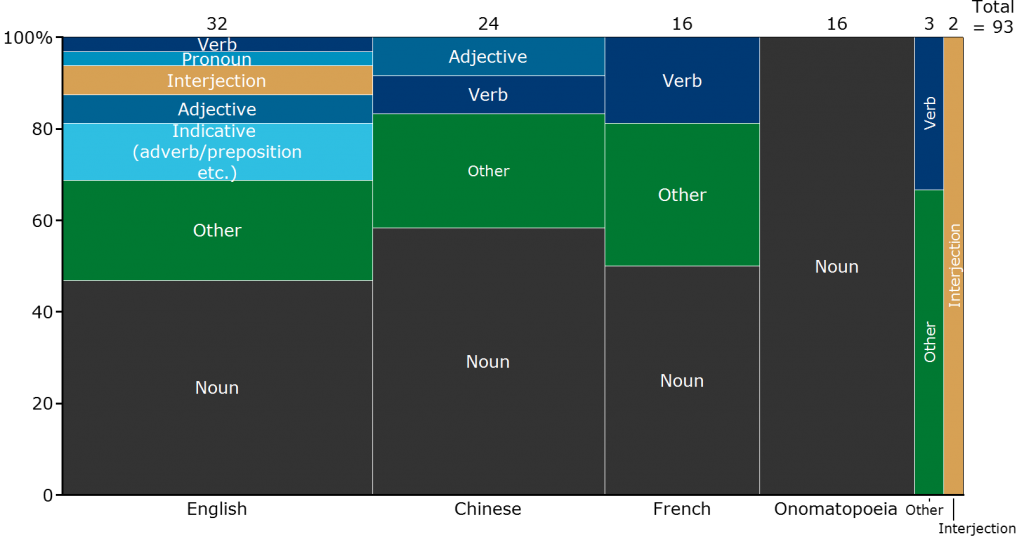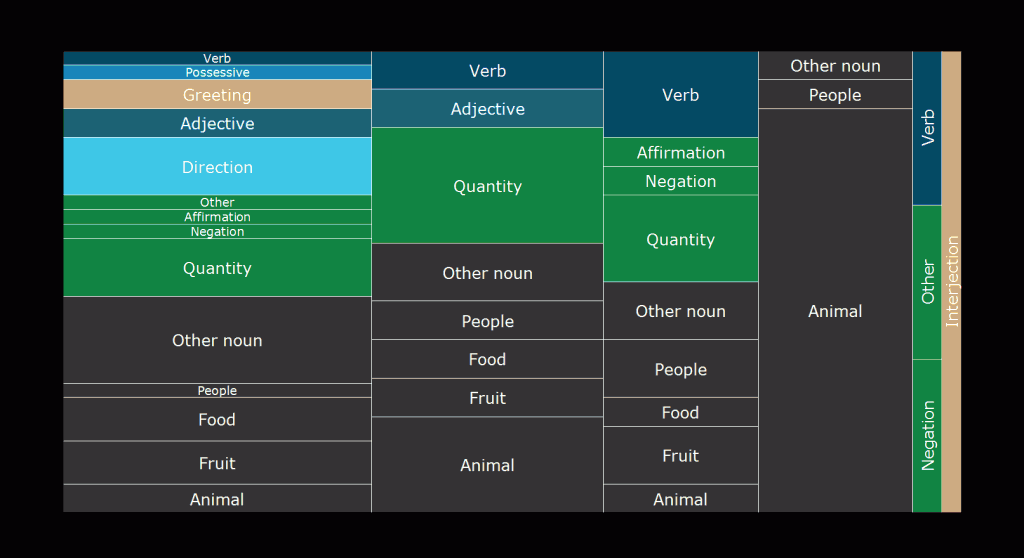Baby-Ao seems to have experienced a developmental leap recently, based on his increased verbosity over the past 2-3 weeks. So we decided to take stock of Baby-Ao’s vocabulary while we were on holiday (and relatively relaxed). We put together a list of the words he has been using the past couple of months and he seems to have ~90 words.
His primary language seems to be English, which comprises 34% of his vocabulary, vs. French at 17% and Chinese at 26%. With the remainder (22%) being onomatopoeic/other.
14 words (15%) are duplicates (3x no, 2x yes, 2x water, 2x apple, 2x car, 2x cow, 2x dog, 2x hot, 2x bubble, 2x ball, 3x one, 3x two, 3x three). Excluding duplicated words, he has 79 unique words.
His vocabulary mainly comprises nouns (57%), which I assume should be normal at this stage.
Clearly my focus on animals has paid off (animals account for 24% of all vocabulary), although it has primarily manifested as animal noises (15%), probably because it can be used in multiple languages.
English, his main language, is where he has the widest range of word types, and a high proportion of non-nouns, which would also make sense.
- ***
English (32, 34%)
{19% other noun, 13% quantity, 13% direction, 9% fruit, 9% food noun, 6% animal, 6% greeting, 6% negation + affirmation, 3% verb, 6% adjective, 3% possessive, 3% other}
– no
– yes
– hello
– bye bye
– up
– down
– more
– there (ta, while pointing)
– mine (mai)
– dog
– bat
– apple (appuh)
– banana (nana)
– pear (peh)
– water (wah tah)
– rice
– bib
– ball
– book (boh)
– car
– keys
– bubbles (ba bah)
– hot (woh, with palm to cheek)
– row row
– eat
– this
– please (peesh)
– one
– two
– four
– babe (beeb)
– pancake
Chinese (24, 26%)
{25% numbers, 21% animals, 8% fruit nouns, 8% food noun, 8% people, 13% other noun, 8% adjective, 8% verb}
– cat (mao)
– dog (gou)
– horse (ma)
– cow (niu)
– chick (ji ji)
– grape (pu ta)
– mandarin/ clementine (ju zi)
– egg (dan)
– milk (nai, with hand sign)
– bubbles (ba bao)
– ma ma
– auntie/ nanny (yi yi)
– ball (qiu)
– doll (wa wa)
– big (da)
– hot (dan dan, with palm to cheek)
– listen (ting ting)
– take (na)
– one (yi)
– two (er)
– five (wu)
– six (liu)
– eight (ba)
– nine (jiu)
French (16, 17%)
{19% quantity, 19% verb, 13% other noun, 13% fruit noun, 13% people, 12% negation + affirmation, 6% food noun, 6% animal}
– no (non)
– yes (oui)
– one (un)
– two (deux)
– poop (caca), used as a verb
– pee pee, used as a verb
– sleep (do do), used as a verb
– peach (peche)
– apple (pomme)
– water (l’eau)
– car (tu tur)
– pa pa
– baby (bebe)
– bisous (bee)
– three (trois)
– tortoise (tortu)
Onomatopoeic/ Indeterminate (20, 22%)
{67% animal, 10% interjection, 5% people, 5% other noun, 5% negation, 5% verb, 5% other}
– quack quack (for duck)
– moo (for cow)
– snorting (for pig)
– pe pe (for hen)/
– ko ko (for cockerel/ rooster)
– kwee kwee (for birds)
– gua gua (for frog)
– ssss (for snake)
– elephant noise (for elephant)
(with trunk arm gesture)
– fish mouth breathing “sound” (for fish)
– howl (for wolf)
– ooo ooo (for owl)
– munching noise (for giraffe)
– wah/roar (for lion, tiger, bear etc)
– choo choo (for train)
– tongue noise (for children)
– EIEIO
– wow
– uh oh
– eat (mam mam)
Other (1,1%)
– nein (no in German)


